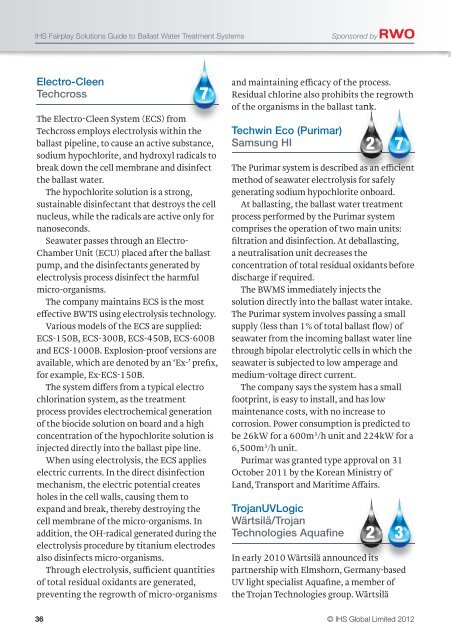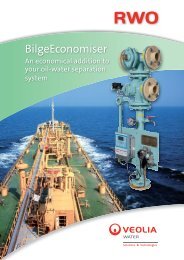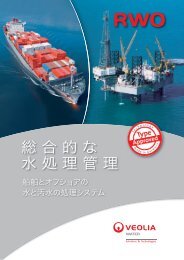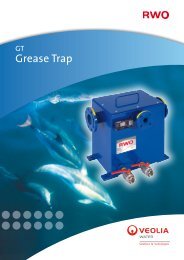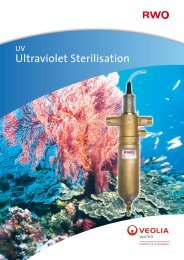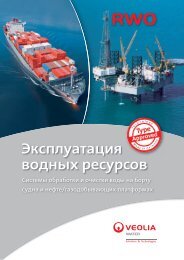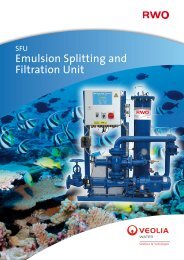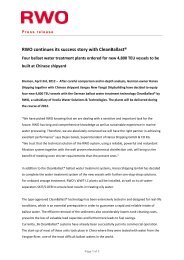the IHS Ballast Water Guide - RWO Marine Water Technology
the IHS Ballast Water Guide - RWO Marine Water Technology
the IHS Ballast Water Guide - RWO Marine Water Technology
Create successful ePaper yourself
Turn your PDF publications into a flip-book with our unique Google optimized e-Paper software.
<strong>IHS</strong> Fairplay Solutions <strong>Guide</strong> to <strong>Ballast</strong> <strong>Water</strong> Treatment Systems Sponsored by<br />
Electro-Cleen<br />
Techcross 7<br />
The Electro-Cleen System (ECS) from<br />
Techcross employs electrolysis within <strong>the</strong><br />
ballast pipeline, to cause an active substance,<br />
sodium hypochlorite, and hydroxyl radicals to<br />
break down <strong>the</strong> cell membrane and disinfect<br />
<strong>the</strong> ballast water.<br />
The hypochlorite solution is a strong,<br />
sustainable disinfectant that destroys <strong>the</strong> cell<br />
nucleus, while <strong>the</strong> radicals are active only for<br />
nanoseconds.<br />
Seawater passes through an Electro-<br />
Chamber Unit (ECU) placed after <strong>the</strong> ballast<br />
pump, and <strong>the</strong> disinfectants generated by<br />
electrolysis process disinfect <strong>the</strong> harmful<br />
micro-organisms.<br />
The company maintains ECS is <strong>the</strong> most<br />
effective BWTS using electrolysis technology.<br />
Various models of <strong>the</strong> ECS are supplied:<br />
ECS-150B, ECS-300B, ECS-450B, ECS-600B<br />
and ECS-1000B. Explosion-proof versions are<br />
available, which are denoted by an ‘Ex-’ prefix,<br />
for example, Ex-ECS-150B.<br />
The system differs from a typical electro<br />
chlorination system, as <strong>the</strong> treatment<br />
process provides electrochemical generation<br />
of <strong>the</strong> biocide solution on board and a high<br />
concentration of <strong>the</strong> hypochlorite solution is<br />
injected directly into <strong>the</strong> ballast pipe line.<br />
When using electrolysis, <strong>the</strong> ECS applies<br />
electric currents. In <strong>the</strong> direct disinfection<br />
mechanism, <strong>the</strong> electric potential creates<br />
holes in <strong>the</strong> cell walls, causing <strong>the</strong>m to<br />
expand and break, <strong>the</strong>reby destroying <strong>the</strong><br />
cell membrane of <strong>the</strong> micro-organisms. In<br />
addition, <strong>the</strong> OH-radical generated during <strong>the</strong><br />
electrolysis procedure by titanium electrodes<br />
also disinfects micro-organisms.<br />
Through electrolysis, sufficient quantities<br />
of total residual oxidants are generated,<br />
preventing <strong>the</strong> regrowth of micro-organisms<br />
and maintaining efficacy of <strong>the</strong> process.<br />
Residual chlorine also prohibits <strong>the</strong> regrowth<br />
of <strong>the</strong> organisms in <strong>the</strong> ballast tank tank. nk nk.<br />
Techwin Eco (Purimar)<br />
Samsung HI<br />
2 7<br />
The Purimar system is described as an efficient<br />
method of seawater electrolysis for safely<br />
generating sodium hypochlorite onboard.<br />
At ballasting, <strong>the</strong> ballast water treatment<br />
process performed by <strong>the</strong> Purimar system<br />
comprises <strong>the</strong> operation of two main units:<br />
filtration and disinfection. At deballasting,<br />
a neutralisation unit decreases <strong>the</strong><br />
concentration of total residual oxidants before<br />
discharge if required.<br />
The BWMS immediately injects <strong>the</strong><br />
solution directly into <strong>the</strong> ballast water intake.<br />
The Purimar system involves passing a small<br />
supply (less than 1% of total ballast flow) of<br />
seawater from <strong>the</strong> incoming ballast water line<br />
through bipolar electrolytic cells in which <strong>the</strong><br />
seawater is subjected to low amperage and<br />
medium-voltage direct current.<br />
The company says <strong>the</strong> system has a small<br />
footprint, is easy to install, and has low<br />
maintenance costs, with no increase to<br />
corrosion. Power consumption is predicted to<br />
be 26kW for a 600m 3 /h unit and 224kW for a<br />
6,500m 3 /h unit.<br />
Purimar was granted type approval on 31<br />
October 2011 by <strong>the</strong> Korean Ministry of<br />
Land, Transport and Maritime Affairs.<br />
TrojanUVLogic<br />
Wärtsilä/Trojan<br />
Technologies Aquafine 2 3<br />
In early 2010 Wärtsilä announced its<br />
partnership with Elmshorn, Germany-based<br />
UV light specialist Aquafine, a member of<br />
<strong>the</strong> Trojan Technologies group. Wärtsilä<br />
36 © <strong>IHS</strong> Global Limited 2012<br />
012_037_CorrectedBW1204.indd 36 01/08/2012 15:38:00


